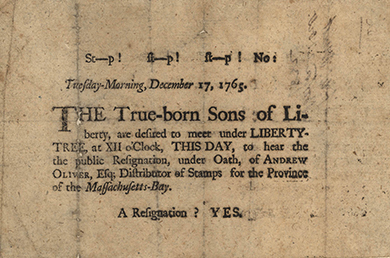| << Chapter < Page | Chapter >> Page > |
Browse the collection of the Massachusetts Historical Society to examine digitized primary sources of the documents that paved the way to the fight for liberty.
The Stamp Act Congress was a gathering of landowning, educated white men who represented the political elite of the colonies and was the colonial equivalent of the British landed aristocracy. While these gentry were drafting their grievances during the Stamp Act Congress, other colonists showed their distaste for the new act by boycotting British goods and protesting in the streets. Two groups, the Sons of Liberty and the Daughters of Liberty , led the popular resistance to the Stamp Act. Both groups considered themselves British patriots defending their liberty, just as their forebears had done in the time of James II.
Forming in Boston in the summer of 1765, the Sons of Liberty were artisans, shopkeepers, and small-time merchants willing to adopt extralegal means of protest. Before the act had even gone into effect, the Sons of Liberty began protesting. On August 14, they took aim at Andrew Oliver, who had been named the Massachusetts Distributor of Stamps. After hanging Oliver in effigy—that is, using a crudely made figure as a representation of Oliver—the unruly crowd stoned and ransacked his house, finally beheading the effigy and burning the remains. Such a brutal response shocked the royal governmental officials, who hid until the violence had spent itself. Andrew Oliver resigned the next day. By that time, the mob had moved on to the home of Lieutenant Governor Thomas Hutchinson who, because of his support of Parliament’s actions, was considered an enemy of English liberty. The Sons of Liberty barricaded Hutchinson in his home and demanded that he renounce the Stamp Act; he refused, and the protesters looted and burned his house. Furthermore, the Sons (also called “True Sons” or “True-born Sons” to make clear their commitment to liberty and distinguish them from the likes of Hutchinson) continued to lead violent protests with the goal of securing the resignation of all appointed stamp collectors ( [link] ).

Starting in early 1766, the Daughters of Liberty protested the Stamp Act by refusing to buy British goods and encouraging others to do the same. They avoided British tea, opting to make their own teas with local herbs and berries. They built a community—and a movement—around creating homespun cloth instead of buying British linen. Well-born women held “spinning bees,” at which they competed to see who could spin the most and the finest linen. An entry in The Boston Chronicle of April 7, 1766, states that on March 12, in Providence, Rhode Island, “18 Daughters of Liberty, young ladies of good reputation, assembled at the house of Doctor Ephraim Bowen, in this town. . . . There they exhibited a fine example of industry, by spinning from sunrise until dark, and displayed a spirit for saving their sinking country rarely to be found among persons of more age and experience.” At dinner, they “cheerfully agreed to omit tea, to render their conduct consistent. Besides this instance of their patriotism, before they separated, they unanimously resolved that the Stamp Act was unconstitutional, that they would purchase no more British manufactures unless it be repealed, and that they would not even admit the addresses of any gentlemen should they have the opportunity, without they determined to oppose its execution to the last extremity, if the occasion required.”

Notification Switch
Would you like to follow the 'U.s. history' conversation and receive update notifications?